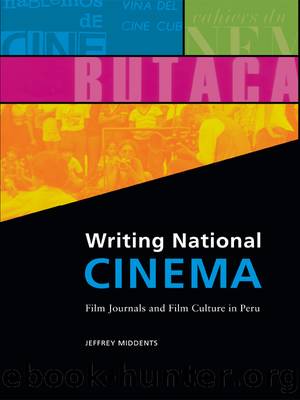Writing National Cinema by Middents Jeffrey;

Author:Middents, Jeffrey;
Language: eng
Format: epub
Publisher: University Press of New England
Similarly, de Izcué doesnât see a place for auteurist cinema within Peruvian national cinema when asked about the films of Sinclair and Robles Godoy. She argues that such a concept âmay work in another context, but not in oursâ as, without much product to work with, even Robles Godoy could not be considered an auteur.
The Encyclopedia of Short Filmmaking
The short-film explosion did not wane: instead, it grew to a point of crisis when too many films were produced to guarantee their exhibition, creating a bottleneck situation where many completed shorts found their release delayed. With no money coming in from the shorts, and with the onset of an international recession of the 1970s, many short-film production companies went bankrupt. At the same time, the successful completion of several feature films in 1977 by filmmakers trained on short films forced the journal to reevaluate its opinion of the short format.
The publication of volume 70 (April 1979) demonstrated a significant ideological shift concerning short films with the first part of a âDiccionario del cortometraje peruanoâ (Encyclopedia of Peruvian short filmmaking), one of the only written records concerning short films made under the Film Law of 1972.29 The most difficult task involved determining the judgment parameters for inclusion in the encyclopedia: not all films were of sufficiently acceptable quality for consideration, nor was it easy to figure out exactly who was responsible for a particular short. The journalâs training in auteur theory (reminiscent of the French and Spanish journals) broke down; as the introduction states, the shorts âhave often been executed by groups that piecemealed their material together ⦠which lends a standard, opaque tone to a large percentage of the shorts and makes it difficult to find significant differences among many directors.â30 Naturally, the large number of films produced over the previous seven years made it impossible for the journal to cover every short film that had been produced. One criterion for inclusion was having produced two films following the creation of the Film Law of 1972, thereby critically assessing the effects of the law first and foremost on the question of industry.
In the history of Hablemos de cine, only the in-depth retrospective of American filmmakers (published in 1968 and 1969 in volumes 39 through 46) matched this serious, detailed exploration of the Peruvian short film. This attention is particularly surprising as such a comprehensive study was never attempted with the features (perhaps because all the features released at this time got their own individual reviews). The publication of the retrospective supports the notion that the short film was relevant to national cinema; in fact, it was the most prominent mode of cinematic production at the time, far more significant than the scant number of features.
All this is not to say that the critics were satisfied to examine shorts on their own terms. On the contrary, the editors still privileged the feature film: the retrospective tracked the fifty filmmakers that most showed promise to make the jump or had already started producing features.
Download
This site does not store any files on its server. We only index and link to content provided by other sites. Please contact the content providers to delete copyright contents if any and email us, we'll remove relevant links or contents immediately.
Kathy Andrews Collection by Kathy Andrews(10693)
The remains of the day by Kazuo Ishiguro(7684)
Spare by Prince Harry The Duke of Sussex(4321)
Paper Towns by Green John(4255)
The Body: A Guide for Occupants by Bill Bryson(3959)
Be in a Treehouse by Pete Nelson(3286)
Harry Potter and the Goblet Of Fire by J.K. Rowling(3223)
Goodbye Paradise(3057)
Never by Ken Follett(3020)
Into Thin Air by Jon Krakauer(2777)
The Remains of the Day by Kazuo Ishiguro(2691)
The Cellar by Natasha Preston(2688)
The Genius of Japanese Carpentry by Azby Brown(2679)
Industrial Automation from Scratch: A hands-on guide to using sensors, actuators, PLCs, HMIs, and SCADA to automate industrial processes by Olushola Akande(2634)
Drawing Shortcuts: Developing Quick Drawing Skills Using Today's Technology by Leggitt Jim(2595)
120 Days of Sodom by Marquis de Sade(2507)
Machine Learning at Scale with H2O by Gregory Keys | David Whiting(2437)
Architecture 101 by Nicole Bridge(2419)
The Man Who Died Twice by Richard Osman(2416)
